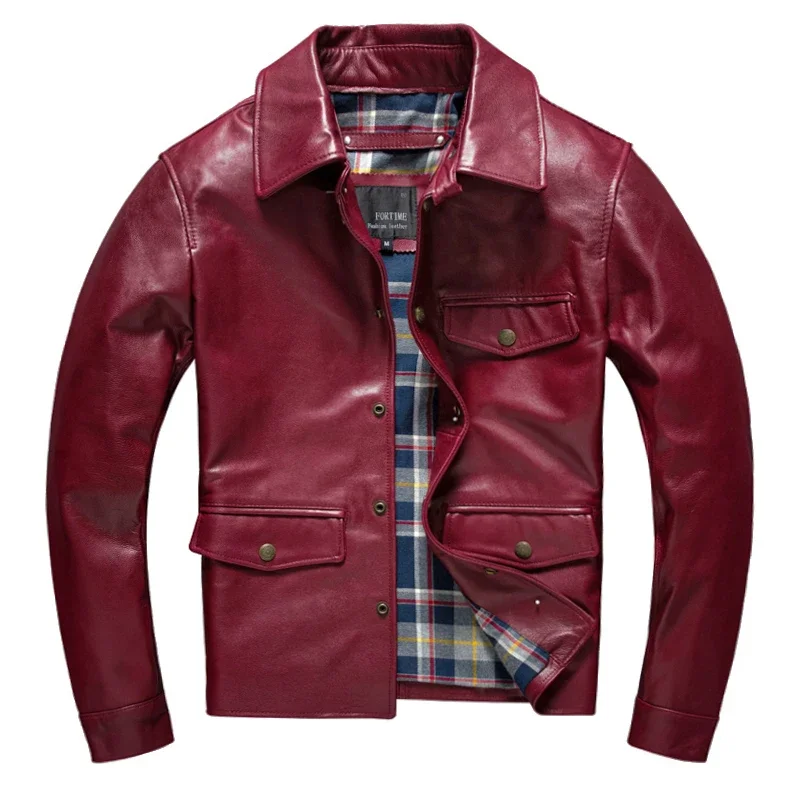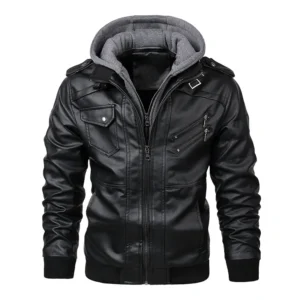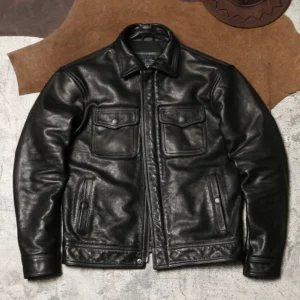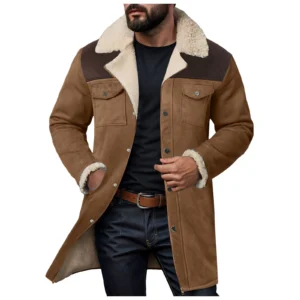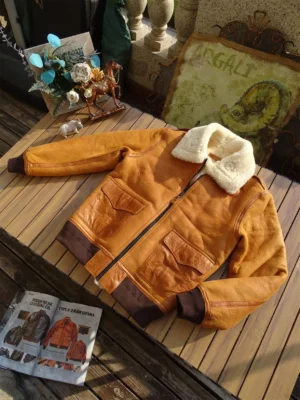Introduction to Leather Jacket Care and Maintenance
Yes, conditioning (often called “oiling”) is essential for leather jackets. As a natural material, leather contains oils that gradually deplete over time, leading to dryness and potential damage if not properly maintained. Just like our skin needs moisturizer, leather requires regular conditioning to remain supple and beautiful.
A well-maintained leather jacket isn’t just a fashion statement—it’s an investment that can last decades rather than just a few years. Neglected leather becomes stiff, cracks, and loses its appeal, while properly conditioned leather ages gracefully, developing character while remaining functional.
In this guide, we’ll cover everything you need to know about leather jacket care:
– Why conditioning is necessary for leather’s longevity
– How to recognize when your jacket needs conditioning
– Which products work best for different leather types
– Step-by-step application methods for optimal results
Understanding leather coat care maintenance is fundamental to preserving your investment, especially when you own quality pieces like our men’s leather and shearling coats.
Why Leather Jackets Need Conditioning: The Science Behind Leather Care
Natural Structure of Leather
Leather is essentially animal skin that has been preserved through tanning. Its structure consists of collagen fibers naturally infused with oils that keep it flexible and resistant to damage. These natural oils are what give leather its distinctive suppleness and comfort.
Factors That Deplete Natural Oils
Environmental Exposure
Sunlight, dry air, and heat gradually evaporate leather’s natural oils. This process accelerates in harsh conditions like direct sunlight or heated indoor environments during winter.
Normal Wear and Handling
Every time you wear your leather jacket, friction and body oils affect the leather’s composition. While some body oils can benefit leather, they’re not sufficient to replace what’s lost through regular use.
Cleaning Processes
Necessary cleaning to remove dirt and grime can strip away protective oils, leaving leather vulnerable if not replenished.
Benefits of Regular Conditioning
Proper leather conditioning isn’t just about maintenance—it’s about preservation and enhancement. Regular conditioning:
– Replenishes moisture and essential oils to prevent brittleness
– Maintains flexibility, ensuring comfortable movement
– Enhances appearance by revitalizing the leather’s natural luster
– Provides mild resistance against water and other elements
– Prevents premature aging and extends your jacket’s lifespan
The expert tips for leather coat conditioning we share with our customers have helped many preserve their jackets for years, and preventing leather coat cracks starts with understanding this fundamental care requirement.
Understanding Terminology: Oiling vs. Conditioning Leather
The terms “oiling” and “conditioning” are often used interchangeably when discussing leather care, but there are important distinctions worth understanding.
Traditionally, “oiling” referred to applying pure oils (like neatsfoot or mink oil) directly to leather. These natural oils penetrate deeply but can sometimes oversaturate leather or cause darkening. Modern leather care has largely shifted toward “conditioning,” which typically involves using specially formulated products that balance various ingredients for optimal leather health.
Today’s leather conditioners usually contain:
– Natural oils in controlled amounts
– Waxes for protection
– Lanolin or other moisturizers
– pH balancers to maintain leather’s chemical stability
These formulations offer better control and more predictable results than pure oils. They’re designed to nourish without over-saturating or dramatically altering the leather’s appearance.
For most contemporary leather jackets, quality conditioners are preferable to pure oils, though both have their place depending on your specific jacket and desired outcome. Understanding different types of leather cleaners and conditioners will help you make the best choice for your specific garment.
Signs Your Leather Jacket Needs Conditioning
Knowing when to condition your leather jacket is as important as knowing how. Look for these telltale indicators:
Dryness and Stiffness
If your once-supple jacket feels rigid or makes a crackling sound when folded, it’s crying out for moisture. Quality leather should feel soft and pliable to the touch.
Fading or Dull Appearance
Healthy, well-conditioned leather has a subtle luster—not shiny, but not flat either. When leather loses its natural sheen and appears dull, it’s likely time for conditioning.
Fine Surface Cracks
Small cracks beginning to form, especially in high-flex areas like elbows and shoulders, indicate the leather is becoming too dry. Early intervention with conditioning can prevent these from worsening.
The Water Drop Test
Place a single drop of water on an inconspicuous area of your jacket. If the water sits on top for a while, your leather still has some protective qualities. If it immediately absorbs, your jacket is thirsty for conditioning.
High-Wear Zones
Check areas that experience the most friction and bending—cuffs, elbows, collar, and seams. These areas typically show signs of dryness first and can guide your conditioning timeline.
Recognizing these signs early can prevent permanent damage to your leather coat and maintain its appearance and functionality for years to come.
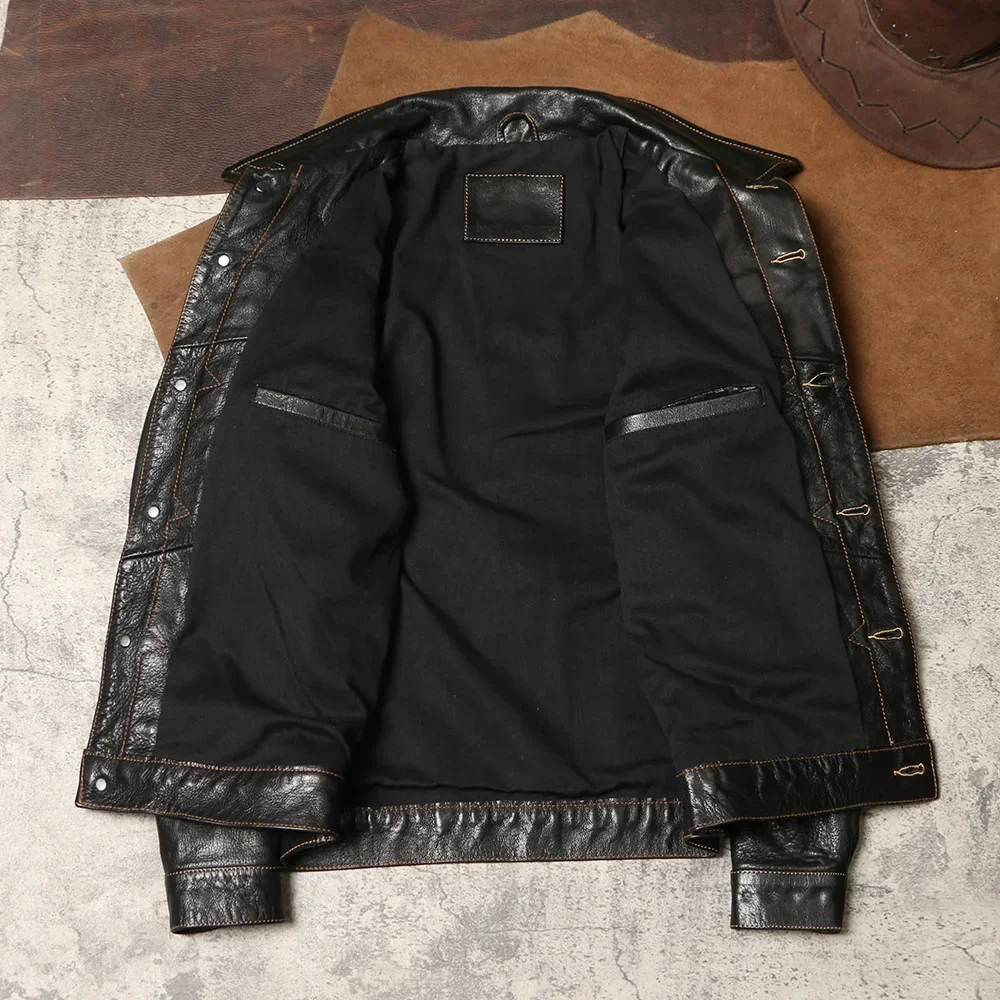
How Often Should You Condition Your Leather Jacket?
Most leather experts recommend conditioning your jacket every 6-12 months under normal circumstances. However, this frequency can vary significantly based on several factors:
Climate and Environment
– Arid regions: More frequent conditioning (every 3-6 months)
– Humid areas: Less frequent conditioning (every 9-12 months)
– Extreme temperature fluctuations: Additional conditioning may be needed
Usage Patterns
– Daily wear: More frequent conditioning
– Occasional wear: Standard conditioning schedule
– Seasonal wear: Condition before storage and after taking out of storage
Leather Type
Different leather types have varying oil content and needs. Understanding genuine leather versus faux leather distinctions becomes important for maintenance schedules, as synthetic alternatives have completely different care requirements.
Warning: Avoid Over-Conditioning
Too much of a good thing can be problematic. Over-conditioning can:
– Saturate the leather, making it feel greasy
– Attract dirt and dust
– Cause stretching or shape distortion
– Create an uneven appearance
The best approach is responsive conditioning—learning to recognize when your leather actually needs attention rather than adhering to a strict calendar schedule.
Selecting the Right Conditioning Products for Different Leather Types
Not all leather is created equal, and neither are leather conditioners. Matching the right product to your specific leather type is crucial for effective care.
For Smooth/Finished Leather
Most leather jackets fall into this category, featuring a protective finish over the leather.
– Best options: Cream-based conditioners that balance moisturizing and protection
– Look for: Products containing natural oils like lanolin, jojoba, or mink oil in moderate amounts
– Application: These leathers can handle slightly heavier conditioning, but moderation remains key
For Aniline/Semi-Aniline Leather
These premium leathers have minimal or no protective coating, showcasing the natural grain and character.
– Best options: Light, non-greasy conditioners specifically formulated for aniline leather
– Look for: Water-based or very light oil formulations
– Application: Apply sparingly to avoid oversaturation
For Suede/Nubuck
These brushed-finish leathers require special care.
– Best options: Specialized suede conditioners and revitalizers only
– Avoid: Standard leather conditioners or oils which will ruin the napped texture
– Application: Always use products specifically designed for suede/nubuck
For Patent Leather
With its glossy, plastic-like finish, patent leather has unique needs.
– Best options: Patent-specific products that clean and shine
– Avoid: Oil-based products that can degrade the finish
– Application: Gentle cleaning is often more important than conditioning
Our sheepskin coats require specific conditioning approaches due to their unique properties, combining leather on one side with wool on the other.
Products to Avoid
Regardless of leather type, steer clear of:
– Household oils (olive, vegetable, coconut)
– Petroleum-based products not designed for leather
– Products containing silicone (creates artificial shine and can trap moisture)
– Harsh chemical cleaners
Step-by-Step Guide: How to Properly Condition Your Leather Jacket
Follow these steps for optimal results when conditioning your leather jacket:
Preparation
- Clean the jacket first: Remove surface dirt and oils by gently wiping with a leather cleaner or mild soap solution. Allow to dry completely.
- Gather supplies:
– Your chosen leather conditioner
– Several soft, lint-free cloths
– A clean, flat workspace - Create the right environment: Work in a well-ventilated area away from direct heat or sunlight. Ideal temperature is 65-75°F (18-24°C).
Application Process
Perform a patch test: Apply a small amount of conditioner to an inconspicuous area (inside collar or under a flap). Wait 24 hours to check for any adverse reactions like darkening or discoloration.
Apply conditioner properly:
– Pour a small amount onto a cloth (not directly on the jacket)
– Work in small, manageable sections
– Apply using gentle circular motions
– Use minimal product—a little goes a long wayAllow proper absorption: Let the conditioner penetrate the leather for 15-30 minutes (follow specific product instructions).
Buff and finish: Using a clean, dry cloth, gently buff the surface to remove any excess conditioner and restore a natural appearance.
Post-Conditioning Care
- Allow the jacket to hang for 24 hours before wearing
- Keep away from heat sources during this curing period
- Hang on a padded hanger in a well-ventilated closet
For best results, clean your leather coat at home before conditioning, as applying conditioner to dirty leather can trap grime and cause damage. This is especially important for maintaining the appearance of black leather coats, where imperfections are often more visible.
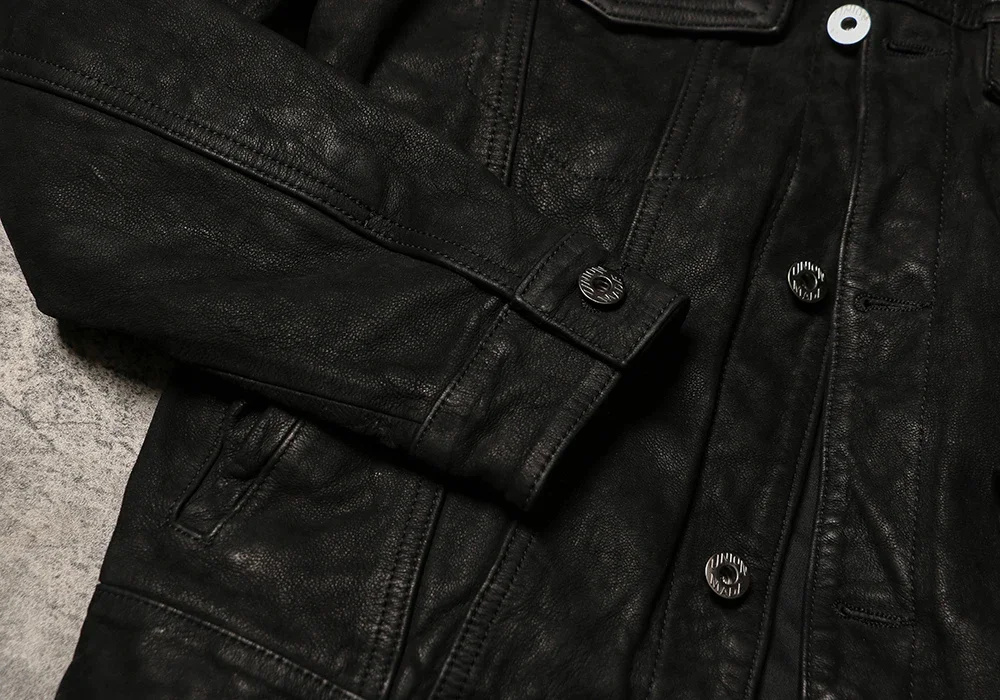
Common Mistakes to Avoid When Conditioning Leather Jackets
Even with the best intentions, leather care can go wrong if you make these common mistakes:
Over-conditioning
Applying too much product or conditioning too frequently can oversaturate leather, making it heavy, greasy, and prone to attracting dirt. Follow the “less is more” principle—you can always add more if needed, but removing excess is difficult.
Using inappropriate products
Household oils, cooking sprays, and other DIY solutions can permanently damage leather. The minimal cost savings isn’t worth risking your valuable jacket. Similarly, using regular leather conditioner on suede or specialized products on regular leather can cause irreversible damage.
Applying conditioner to dirty leather
Conditioning without cleaning first traps dirt particles in the leather, potentially causing abrasive damage and discoloration over time.
Skipping the patch test
Some conditioners can darken or alter leather colors, especially on lighter jackets. Always test in a hidden area first to avoid unwelcome surprises.
Uneven application
Applying conditioner haphazardly leads to an unbalanced appearance with some areas looking darker or shinier than others. Work methodically in sections with consistent pressure.
Using heat to speed drying
Hairdryers, heaters, or sunlight can cause leather to dry out unevenly or crack. Natural air-drying is always the safest approach.
Protecting your leather jacket properly means avoiding these mistakes and following established best practices that have stood the test of time.
Specialized Care for Different Leather Jacket Types
Different leather varieties require tailored care approaches to maintain their unique characteristics:
Full-Grain and Top-Grain Leather
These premium leathers showcase natural markings and develop beautiful patinas over time.
– Conditioning approach: Use quality cream conditioners that enhance natural character
– Application: Moderate amounts, focusing on maintaining even absorption
– Special consideration: These leathers may darken slightly with conditioning—embrace this as part of their evolving character
Aniline and Semi-Aniline Leather
With minimal surface treatment, these leathers are more susceptible to staining but offer unparalleled natural beauty.
– Conditioning approach: Very light application of specialized aniline conditioners
– Frequency: Potentially more often but with less product each time
– Special consideration: Extra caution around water and stains is necessary
Suede and Nubuck
These velvety, brushed leathers require completely different care.
– Conditioning approach: Use only dedicated suede/nubuck products
– Application: Light misting rather than rubbing in
– Special consideration: Regular brushing with a suede brush is as important as conditioning
Vintage and Aged Leather
Older leather often has different needs than modern variants.
– Conditioning approach: More frequent but lighter applications
– Product selection: Consider conditioners with restorative properties
– Special consideration: May require professional assessment if severely dried out
Mens Leather Coat, Mens Long Leather Coat
Price range: $225.22 through $235.58 Select options This product has multiple variants. The options may be chosen on the product pageMens Black Leather Coat, Mens Leather Coat
Price range: $181.52 through $197.20 Select options This product has multiple variants. The options may be chosen on the product pageMens Brown Leather Coat, Mens Leather Coat
$846.94 Select options This product has multiple variants. The options may be chosen on the product pageMens Shearling Coat, Mens Sheepskin Coat
$888.08 Select options This product has multiple variants. The options may be chosen on the product page- Price range: $96.28 through $130.88 Select options This product has multiple variants. The options may be chosen on the product page
Mens Shearling Coat, Mens Sheepskin Coat
$2,257.19 Select options This product has multiple variants. The options may be chosen on the product page
Our shearling coats combine smooth leather with natural sheep’s wool, requiring specialized care to maintain both components. Understanding your specific jacket type ensures you’ll provide the appropriate treatment to maintain its unique qualities.
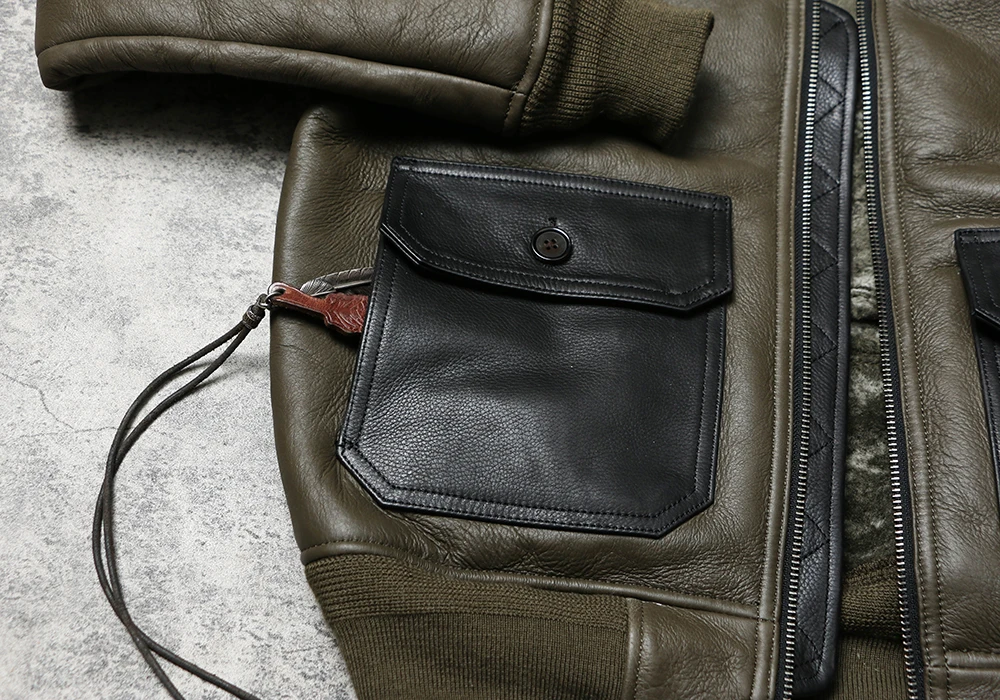
Beyond Conditioning: Complete Leather Jacket Maintenance Guide
While conditioning is crucial, comprehensive leather jacket care involves several other important practices:
Proper Storage
– Use padded hangers that support shoulders without creating pressure points
– Allow space between garments for air circulation
– Store in breathable cotton garment bags rather than plastic
– Keep away from direct sunlight and heat sources
– Avoid damp or humid storage areas
Managing Water Exposure
– If your jacket gets wet, blot (don’t rub) with a clean towel
– Allow to air dry naturally away from direct heat
– Once dry, assess if conditioning is needed to restore moisture balance
– Consider applying a water-resistant treatment designed for leather
Handling Common Stains
– Address spills immediately by blotting (not rubbing)
– For oil-based stains, use a small amount of talcum powder to absorb excess oil
– For persistent stains, consult a professional leather cleaner
– Always test any cleaning solution on an inconspicuous area first
Professional Care
Consider professional cleaning and conditioning services when:
– Dealing with valuable or vintage pieces
– Addressing significant staining or damage
– Restoring severely dried or cracked leather
– Handling specialty leathers you’re not comfortable treating yourself
Understanding long-term leather coat storage and waterproofing options for leather coats will complement your conditioning routine and ensure comprehensive care.
FAQ: Common Questions About Leather Jacket Conditioning
Can I use household oils like olive or coconut oil on my leather jacket?
No, household oils aren’t formulated for leather and can cause rancidity, unpleasant odors, and accelerated deterioration. They may provide short-term softening but cause long-term damage. Always use products specifically designed for leather care.
Will conditioning darken my leather jacket?
Most conditioners will temporarily darken leather while wet, but quality products return to near-original color once dry. However, some darkening may occur, especially with natural or lighter-colored leathers. This is why patch testing is essential before full application.
How long should I let the conditioner absorb?
Most conditioners need 15-30 minutes to properly penetrate leather, but always follow the specific product instructions. Factors like leather type, product formulation, and environmental conditions can affect absorption time.
What if I applied too much conditioner?
If your leather feels greasy or sticky, gently buff the surface with a clean, dry cloth to remove excess. For severe over-conditioning, you may need to use a leather cleaner to remove the residue and start fresh with a lighter application.
Can I condition vintage or antique leather jackets?
Yes, but with caution. Older leather often needs moisture restoration but may be more fragile. Use gentle products specifically designed for vintage leather, and consider consulting a leather restoration expert for valuable pieces.
Is it necessary to condition new leather jackets?
While new jackets generally have adequate protection, a light conditioning after several months of wear helps maintain their protective qualities. Some experts recommend conditioning new leather to establish good care habits from the start.
For more comprehensive information about maintaining your jacket over years of wear, our long-term leather coat care guide provides valuable insights. You might also be interested in our selection of brown leather coats that respond beautifully to proper conditioning.
At Metro Cloak, we believe that investing in proper leather care extends the life of your premium outerwear, ensuring you enjoy your investment for years to come.

